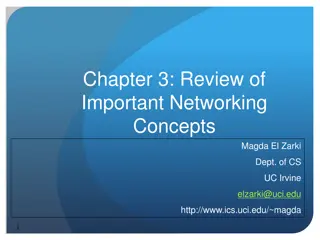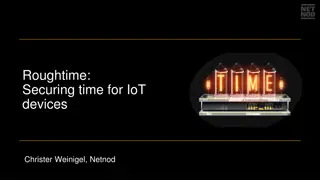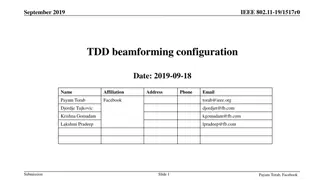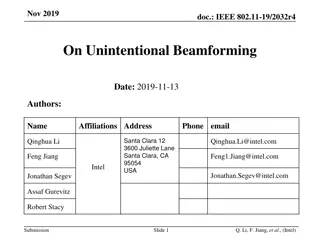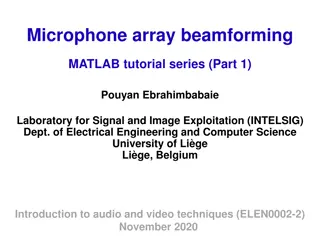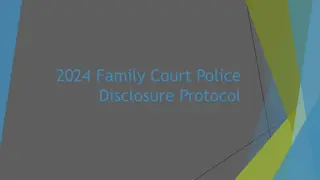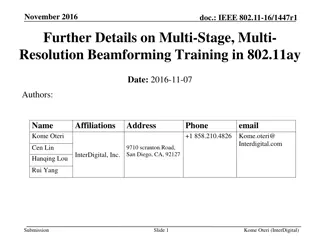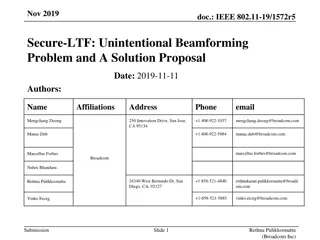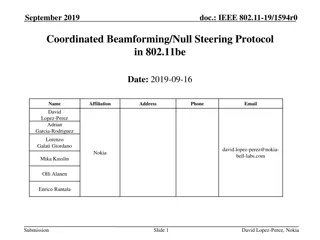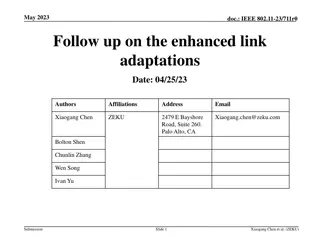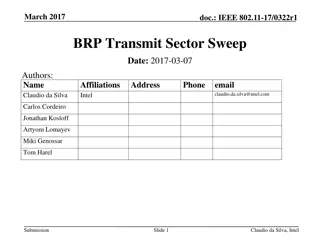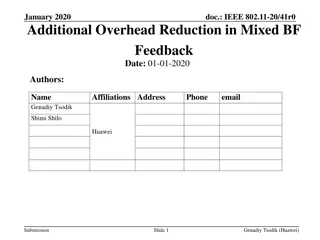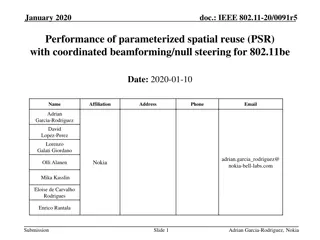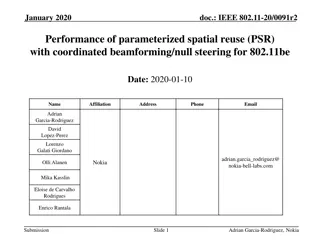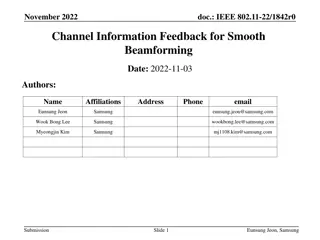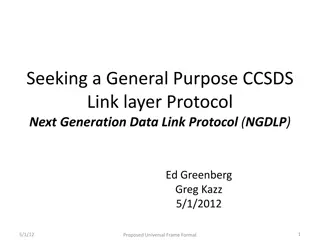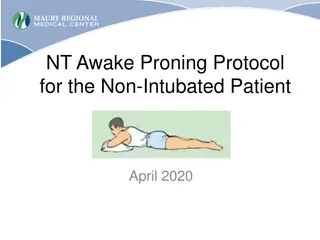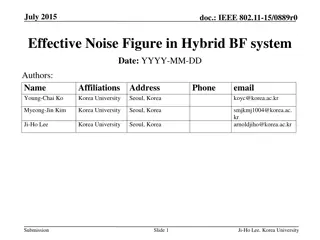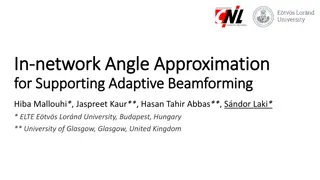Adaptive Tree-based Convergecast Protocol
Adaptive tree-based protocol for managing overlay networks in heterogeneous networks. It proposes improvements to the existing Tree-Based Convergecast Routing (TBCR) protocol by considering additional parameters such as RTT, power consumption, link stability, and link mobility to optimize routing de
32 views • 12 slides
Addressing 5G Signaling Protocol Vulnerabilities
The 8th meeting of the Communications Security, Reliability, and Interoperability Council to discuss and address security vulnerabilities in the newly adopted 5G signaling protocol, HTTP/2. Learn about potential risks, recommended safeguards, and the prevention of these vulnerabilities in the upcomi
3 views • 85 slides
Suicide Prevention & Postvention Protocol
This protocol provides practical advice and support for schools and colleges in Hampshire to navigate the aftermath of a suspected suicide among students or staff members. It includes guidance on interventions, critical incident response, and resources to support the bereaved. Key stages of the post
0 views • 37 slides
Comprehensive ICU Protocol for Sedation, Analgesia, and Delirium Control by Dr. Vinod Srivastava
This comprehensive ICU protocol by Dr. Vinod Srivastava, an Associate Professor in Anaesthesiology & Critical Care at KGMU, covers key aspects such as sedation, analgesia, delirium assessment and control, stress ulcer and deep vein thrombosis prophylaxis, and glycaemic control in the ICU setting. Th
1 views • 50 slides
Understanding Coordinated Beamforming and MU-MIMO in IEEE 802.11-23/1998r0
This document delves into the intricacies of Coordinated Beamforming (Co-BF) and MU-MIMO techniques in the context of IEEE 802.11-23/1998r0 standard. It explores the concept of nulling in Co-BF, handling more Rx antennas than streams, Zero-Forcing precoding to eliminate Multi-User Interference (MUI)
2 views • 22 slides
Channel Information Feedback Enhancement for Improved Beamforming Performance
Beamforming plays a crucial role in achieving high throughput in wireless networks, but issues with discontinuity in beamforming lead to performance limitations. This document discusses the challenges with current beamforming practices and proposes a solution by increasing feedback overhead to enhan
2 views • 17 slides
Important Networking Concepts Overview
Review essential networking concepts including protocol architecture, protocol layers, encapsulation, network abstractions, communication architecture, and TCP/IP protocol suite. Understand the functions of different layers in networking for reliable data transfer and communication efficiency.
3 views • 43 slides
Roughtime: Securing time for IoT devices
Accurate time is crucial for security protocols like DNSSEC and TLS in IoT devices. Roughtime protocol, with improved accuracy and security features, provides a solution for securing time in resource-constrained environments. The protocol addresses the bootstrapping problem and allows for microsecon
1 views • 8 slides
ML-Aided Channel Classification for WLAN Optimization
The paper discusses using machine learning to classify IEEE channel models and improve WLAN performance. It demonstrates how neural networks can accurately classify channel types, leading to efficient beamforming and signal processing. Simulation results show the classification performance even at l
0 views • 12 slides
Understanding OSI Model and TCP/IP Protocol Suite
Explore the concept of layering in data communication, comparing the OSI model and TCP/IP protocol suite. Learn about protocol layers, protocol hierarchies, and the functionality of each layer in these models. Discover the interrelationships between layers and the evolution from OSI to TCP/IP.
5 views • 57 slides
London Homeless Coalition (LHC) Death Communication Protocol
In 2014, the Memorial Committee of the London Homeless Coalition (LHC) established the Death Communication Protocol to acknowledge, share, and address the loss of individuals experiencing homelessness. The protocol aims to inform partnering organizations of confirmed or unconfirmed deaths, support g
0 views • 12 slides
Understanding Mobile Computing and TCP/IP Protocol Suite
Mobile computing is crucial for continuous internet connectivity regardless of physical location. The TCP/IP protocol suite, consisting of Transmission Control Protocol (TCP) and Internet Protocol (IP), forms the backbone of internet infrastructure. IP addressing and mobility challenges are addresse
1 views • 51 slides
Understanding OSI Model and TCP/IP Protocol Suite in Computer Networking
This chapter explores the OSI model and TCP/IP protocol suite, delving into protocol layers, addressing mechanisms, and network components. It highlights the interface between layers, functions of each layer in the OSI model, and compares TCP/IP protocol suite layers with OSI model layers. The discu
0 views • 30 slides
IEEE 802.11-19/1517r0 TDD Beamforming Configuration Overview
IEEE 802.11-19/1517r0 discusses TDD beamforming operations related to Beam Measurement in the standard. Before Draft 4.0, these operations were primarily initiated by SME, causing limitations due to proprietary network controllers. The document reviews gaps and improvements in TDD beamforming, aimin
0 views • 10 slides
MAAP Protocol Overview in IEEE 1722: Address Acquisition and Message Format
The MAAP (Multicast Address Acquisition Protocol) is defined in IEEE 1722 for time-sensitive applications in bridged local area networks. It involves acquiring multicast addresses through claiming, probing, and defending messages. MAAP enables dynamic allocation of addresses and defending against co
1 views • 8 slides
IEEE 802.11-20/1761r1 Ranging Protocol for 11bd
This document outlines the ranging protocol proposed for IEEE 802.11-20/1761r1, focusing on RTT-based ranging leveraging multi-channel operation. By integrating the 11az ranging protocol, it enables flexible and low-overhead application in 11bd for improved accuracy in ITS bands. The protocol includ
1 views • 13 slides
Understanding EIGRP: A Comprehensive Overview
Enhanced Interior Gateway Routing Protocol (EIGRP) is a dynamic routing protocol providing various advantages to network administrators. It is a classless routing protocol supporting VLSM and is considered an Interior Gateway Protocol (IGP). EIGRP uses advanced distance vector routing and is known f
1 views • 5 slides
Unintentional Beamforming in IEEE 802.11-19/2032r4
Contribution on unintentional beamforming in IEEE 802.11-19/2032r4 addressing potential problems and solutions for secure ranging, involving issues with signal interference and power diminishing. Discussions include the impact on received power and robustness enhancements for signal transmission.
2 views • 10 slides
Introduction to Microphone Array Beamforming: MATLAB Tutorial Series
Explore microphone array beamforming techniques in this MATLAB tutorial series by Pouyan Ebrahimbabaie from the Laboratory for Signal and Image Exploitation at the University of Liège, Belgium. Learn about acoustic array geometry, signal processing, time-delay beamforming, and more to enhance audio
0 views • 27 slides
Understanding SFTP Server Functionality with ACS 5.x by Mohammad Azharuddin AAA Team
SFTP (SSH File Transfer Protocol) is a secure network protocol for file access, transfer, and management over reliable data streams. It enhances security by extending the SSH protocol and can be implemented using a reliable 8-bit byte stream protocol. SFTP commands are sent as 4 ASCII letters follow
4 views • 23 slides
Enhanced Family Court Police Disclosure Protocol for 2024
The 2024 Family Court Police Disclosure Protocol addresses key issues identified in the 2013 protocol, emphasizing timely and proportionate requests for material. Changes include a new checklist for the judiciary, guidance notes, and revised processes for litigants in person. The protocol provides c
1 views • 19 slides
Essential Elements of Clinical Trial Protocols
Understanding the key components of a clinical trial research protocol is essential for conducting successful studies. This includes identifying session objectives, discussing trial protocol contents, exploring observational study elements, and learning about reporting guidelines. Study objectives f
1 views • 25 slides
Enhancements in Multi-Stage Beamforming Training for IEEE 802.11ay
IEEE 802.11ay introduces improvements in beamforming training procedures for efficiency and MIMO support. The multi-stage, multi-resolution beamforming training framework enhances beamforming efficiency with high-resolution beams. The proposal includes a Sector Sweep frame and support for up to 2048
0 views • 19 slides
Unintentional Beamforming Issue in IEEE 802.11-19/1572r5 Secure-LTF Design
This document addresses a potential problem in the secure LTF sequence design of IEEE 802.11-19/1572r5, focusing on unintentional beamforming during multi-stream scenarios which can lead to dynamic range complications at the receiver. The proposal offers a solution to mitigate this issue by revising
0 views • 28 slides
Coordinated Beamforming/Null Steering Protocol in IEEE 802.11be
Coordinated beamforming/null steering is a promising scheme in IEEE 802.11be for joint transmission/reception challenges. This protocol aims to efficiently realize gains by establishing semi-static inter-AP coordination, enhancing spatial reuse opportunities, implementing CSI acquisition, and managi
0 views • 15 slides
Multi-Stage, Multi-Resolution Beamforming Training for IEEE 802.11ay
In September 2016, a proposal was introduced to enhance the beamforming training procedures in IEEE 802.11ay for increased efficiency and MIMO support. The proposal suggests a multi-stage, multi-resolution beamforming training framework to improve efficiency in scenarios with high-resolution beams a
0 views • 11 slides
IEEE 802.11-23/711r0 May 2023 Document Summary: Enhanced Link Adaptation Discussions
The May 2023 document IEEE 802.11-23/711r0 discusses topics like beamforming feedback, closed-loop rate adaptations, and issues related to beamforming feedback in a wireless communication context. It elaborates on the challenges of feedback optimization and post-SNR degradation, suggesting solutions
0 views • 15 slides
IEEE 802.11-17/0322r1 BRP Transmit Sector Sweep Protocol
This presentation introduces a sector sweep protocol for beamforming training using BRP frames in IEEE 802.11-17/0322r1 standard. The protocol aims to enhance the efficiency of transmit sector sweep processes for devices with multiple antennas/subarrays, operating over specified frequency channels.
1 views • 15 slides
Techniques for Additional Overhead Reduction in Mixed Beamforming Feedback
Explore the properties of Mixed Beamforming (Mixed BF) and discover a method to reduce feedback size while maintaining high performance. Dive into the analysis of narrowband precoder properties to identify opportunities for size reduction without significant impact on total power. Enhance your under
0 views • 12 slides
Sync HotStuff: Practical Synchronous State Machine Replication
Sync HotStuff is a practical synchronous protocol that tolerates Byzantine replicas and handles weaker synchrony models. It overcomes issues of requiring a large number of rounds and lock-step execution. The protocol ensures safety by committing blocks and guarantees liveness by continuing to commit
0 views • 15 slides
Performance Evaluation of Parameterized Spatial Reuse with Coordinated Beamforming for IEEE 802.11be
The study focuses on assessing the performance of parameterized spatial reuse (PSR) with coordinated beamforming/null steering for IEEE 802.11be. The framework allows coordinated sharing of uplink transmission opportunities among APs, demonstrating gains in synchronous coordinated beamforming system
0 views • 19 slides
Performance Evaluation of Coordinated Beamforming with Parameterized Spatial Reuse in IEEE 802.11be
The document discusses the performance evaluation of coordinated beamforming with parameterized spatial reuse (PSR) in IEEE 802.11be. It explores the practical operation of the 802.11ax PSR framework with null steering and the key implementation benefits, emphasizing unsynchronized operation and ada
0 views • 20 slides
Channel Information Feedback for Beamforming Enhancement
Beamforming is essential for achieving high throughput in wireless communication, but it still requires improvements, especially when combined with channel smoothing techniques. This document discusses the challenges of discontinuities in beam-steering matrices and proposes a feedback mechanism for
0 views • 13 slides
Smooth Beamforming with Feedback Overhead Reduction in IEEE 802.11-23
This document discusses a method for reducing feedback overhead in smooth beamforming to optimize phase rotations for V matrix in IEEE 802.11-23 standard. It explores V matrix optimization, column-wise phase shift, and beamformer side optimization to achieve channel smoothing gain at the receiver si
0 views • 14 slides
Understanding Protocol Deviations in Clinical Trials
Protocol deviations are expected occurrences in clinical trials that may arise from site or participant actions. It is crucial for research teams to identify, report, and learn from these deviations to ensure the integrity and safety of the study. Mechanisms for identifying and reporting deviations,
0 views • 16 slides
Understanding OSI Model and TCP/IP Protocol Suite in Computer Networking
This content delves into the OSI model and TCP/IP protocol suite, highlighting the protocol layers, addressing mechanisms, and communication scenarios. It explores the functions of each layer, the interface between layers, and compares the TCP/IP layers with the OSI model. Through examples and illus
0 views • 46 slides
Seeking a General-Purpose CCSDS Link Layer Protocol: Next-Generation Data Link Protocol (NGDLP)
This document discusses the proposed Universal Frame Format for a next-generation data link protocol, focusing on major questions about transfer frames, Protocol Link Transmission Unit (PLTU), and Universal Transfer Frame Structure. It explores topics such as frame formats, telemetry transfer frames
0 views • 24 slides
NT Awake Proning Protocol for Non-Intubated Patients
This protocol outlines the benefits and procedure for prone positioning in non-intubated patients experiencing mild to moderate hypoxemia. It highlights patient eligibility criteria, equipment required, and considerations for nursing care. The protocol emphasizes improving oxygenation by promoting a
0 views • 11 slides
Noise Figure Analysis in Hybrid Beamforming Systems
This document discusses the theoretical study of noise figure (NF) and gain in hybrid beamforming systems, focusing on the impact of additional RF blocks, such as phase shifters and combiners, on noise figure calculations. It explains how the received signals from multiple antennas are phase-correct
0 views • 11 slides
Beamforming in mmWave Transmission for 5G Networks
Adaptive beamforming plays a vital role in supporting mmWave transmission in 5G networks, addressing challenges like high propagation loss and signal blockage. The use of an innovative user-assisted approach, involving angle computation and configuration messages, enhances the beamforming process fo
0 views • 18 slides






